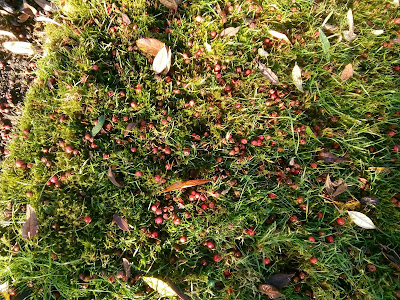Exhibit One, M'lud:
This is the lawn under a spreading Cotoneaster tree - probably C. waterii, I'm not sure.
And just to remind you all (I'm grinning at my current Trainee, who struggles with this one), it's pronounced K'Tony-aster.
Not cotton-easter. K'Tony-Aster.
Every year this K'Tony-Aster produces hundreds of berries, which blanket the ground underneath the tree - it's partly in a shrubbery, partly overhanging the lawn.
I rake up the berries on the beds with ease, but it's a lot harder to get them out of the lawn, and a lot of them get "squashed" into the grass as people walk over them
So why is this lawn not knee-deep in Cotoneaster seedlings, I wonder?
In fact, I wonder this every year! I have yet to see a single seedling, in the lawn or in the bed, which seems odd, bearing in mind the sheer volume of them.
There is a Sycamore tree in next door's garden, and every year we have
hundreds and hundreds of Sycamore seedlings: they pop up in between the
patio slabs, in the beds, in the lawn, everywhere: I regularly spend
several hours in early spring just weeding the patio!
So why isn't there an equivalent Cotoneaster seedling forest?
Wednesday, 1 January 2020
3 comments:
Comments take around 2 days to appear: please be patient. Excessive SPAM has forced me to restrict comments to just Members: if you have a question, you can become a Member: or you can hop over to Patreon and join me there: or you can email me direct - my email address is in the right-hand pane. Sorry about this, but honestly, the spam! I'm drowning in it!!
Note: only a member of this blog may post a comment.
Subscribe to:
Post Comments (Atom)


Or the jokey "Cotton Easter"...
ReplyDelete...but to answer your question see https://www.fs.fed.us/rm/pubs_series/wo/wo_ah727/wo_ah727_442_446.pdf Stratification and weed removal for 5 years are suggested if raising from seed. Passing through the digestive tract of a bird might also help.
ReplyDeleteThanks, Mal, that's fascinating - I had no idea that K'tony-aster were so hard to propagate, as in other gardens, I do find seedlings popping up all over the place. There's one in particular which is very free-seeding, I must make an effort to identify it. It's not a particularly nice one, certainly not as lovely as this one, it's more of a scruffy upright shrub. Ironic but unsurprising that the desirable one is hard to propagate, and the unlovely one is easy peasy!
Delete